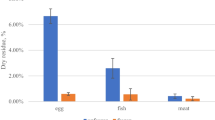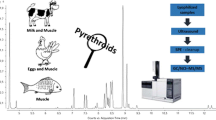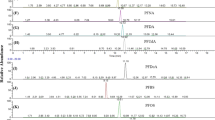Abstract
In this study, a simple, fast, and cheap sample preparation procedure for the analysis of three well-known representatives of perfluoroalkyl substances (perfluorooctane sulfonate, perfluorooctanoic acid, and perfluorooctane sulfonamide) was validated in accordance with Commission Decision 2002/657/EC. The method was based on extraction with methanol followed by a dispersive solid phase extraction cleanup step by addition of activated charcoal for fish tissue, fish feed, and milk samples. The novel analytical approach combined with liquid chromatography–tandem mass spectrometry makes it possible to achieve limits of quantification below 1 μg/kg (defined by Commission Recommendation 2010/161/EU). This method provides a high laboratory sample throughput: ten samples in 60 min. The validated procedure was successfully verified in an interlaboratory study.


Similar content being viewed by others
References
Kissa E (2001) Fluorinated surfactants and repellents. Dekker, New York
Buck RC, Franklin J, Berger U, Conder JM, Cousin IT, De Voogt P, Jensen AA, Kannan K, Mabury SA, Van Leeuwen SPJ (2011) Perfluoroalkyl and polyfluoroalkyl substances in the environment: technology, classification, and origins. Integr Environ Assess Manag 7:513–541
Van Leeuwen SPJ, Van Velzen MJM, Swart CP, Van der Veen I, Traag WA, De Boer J (2009) Halogenated contaminants in farmed salmon, trout, tilapia, pangasius, and shrimp. Environ Sci Technol 43:4009–4015
Malinsky MD, Jacoby CB, Reagen WK (2011) Determination of perfluorinated compounds in fish fillet homogenates: method validation and application to fillet homogenates from the Mississippi River. Anal Chim Acta 683:248–257
Tomy GT, Budakowski W, Halldorson T, Helm PA, Stern GA, Friesen K, Pepper K, Tittlemier SA, Fisk AT (2004) Biotransformation of N-ethyl perfluorooctanesulfonamide by rainbow trout (Onchorhynchus mykiss) liver microsomes. Environ Sci Technol 38:6475–6481
Martin JW, Smithwick MM, Braune BM, Hoekstra PF, Muir DCG, Mabury SA (2004) Analytical challenges hamper perfluoroalkyl research. Environ Sci Technol 38:373–380
Moody CA, Martin JW, Kwan WC, Muir DCG, Mabury SA (2002) Monitoring perfluorinated surfactants in biota and surface water samples following an accidental release of fire-fighting foam into Etobicoke Creek. Environ Sci Technol 36:545–551
Berger U, Glynn A, Holmström KE, Berglund M, Ankarberg EH, Törnkvist A (2009) Fish consumption as a source of human exposure to perfluorinated alkyl substances in Sweden – analysis of edible fish from Lake Vättern and the Baltic Sea. Chemosphere 76:799–804
Delinsky AD, Strynar MJ, Nakayama SF, Varns JL, Ye XB, McCann PJ, Lindstrom AB (2009) Determination of ten perfluorinated compounds in blue gill sunfish (Lepomis macrochirus) fillets. Environ Res 109:975–984
Bustnes JO, Lie E, Herzke D, Dempster T, Bjørn PA, Nygård T, Uglem I (2010) Salmon farms as a source of organohalogenated contaminants in wild fish. Environ Sci Technol 44:8736–8743
Commission Recommendation 2010/161/EU of 17 March 2010 on the monitoring of perfluoroalkylated substances in food
Gosetti F, Chiuminatto U, Zampieri D, Mazzucco E, Robotti E, Calabrese G, Gennaro MC, Marengo E (2010) Determination of perfluorochemicals in biological, environmental and food samples by an automated on-line solid phase extraction ultra high performance liquid chromatography tandem mass spectrometry method. J Chromatogr A 1217:7864–7872
Hansen KJ, Clemen LA, Ellefson ME, Johnson HO (2001) Compound-specific, quantitative characterization of organic fluorochemicals in biological matrices. Environ Sci Technol 35:766–770
Kuklenyik Z, Reich JA, Tully JS, Needhem LL, Calafat AM (2004) Automated solid-phase extraction and measurement of perfluorinated organic acids and amides in human serum and milk. Environ Sci Technol 38:3698–3704
Taniyasu S, Kannan K, So MK, Gulkowska A, Sinclair E, Okazawa T, Yamashita N (2005) Analysis of fluorotelomer alcohols, fluorotelomer acids, and short- and long-chain perfluorinated acids in water and biota. J Chromatogr A 1093:89–97
Van Leeuwen SPJ, Kärrman A, van Bavel B, De Boer J, Lindström G (2006) Struggle for quality in determination of perfluorinated contaminants in environmental and human samples. Environ Sci Technol 40:7854–7860
So MK, Taniyasu S, Lam PKS, Zheng GJ, Giesy JP, Yamashita N (2006) Alkaline digestion and solid phase extraction methods for perfluorinated compounds in mussels and oysters from South China and Japan. Arch Environ Contam Toxicol 50:240–248
Powley CR, Buck RC (2005) Matrix-effect free analytical methods for the determination of perfluorinated carboxylic acids in biological matrices. Fluoros an international symposium on fluorinated alkyl organics in the environmental. 19–20 August 2005, Toronto, Canada (abstract ANA022). http://www.chem.utoronto.ca/symposium/fluoros/analytical.htm. Accessed 2 Nov 2011
Luque N, Ballesteros-Gómez A, Van Leeuwen SPL, Rubio S (2010) Analysis of perfluorinated compounds in biota by microextraction with tetrahydrofuran and liquid chromatography/ion isolation-based ion-trap mass spectrometry. J Chromatogr A 1217:5913–5921
Lacina O, Hradkova P, Pulkrabova J, Hajslova J (2011) Simple, high throughput ultra-high performance liquid chromatography/tandem mass spectrometry trace analysis of perfluorinated alkylated substances in food of animal origin: milk and fish. J Chromatogr A 1218:4312–4321
Berger U, Håukas M (2005) Validation of a screening method based on liquid chromatography coupled to high-resolution mass spectrometry for analysis of perfluoroalkylated substances in biota. J Chromatogr A 1081:210–217
Gulkowska A, Juany Q, So MK, Taniyasu S, Lam PKS, Yamashita N (2006) Persistent perfluorinated acids in seafood collected from two cities of China. Environ Sci Technol 40:3736–3741
Oliveiro-Verbel J, Tao L, Johnson-Restrepo B, Guette-Fernández J, Baldiris-Avila R, O'byrne-Hoyos I, Kannan K (2006) Perfluorooctanesulfonate and related fluorochemicals in biological samples from the north coast of Colombia. Environ Pollut 142:367–372
Nania V, Pellegrini GE, Fabrizi L, Sesta G, De Sanctis P, Lucchetti D, Di Pasquale M, Coni E (2009) Monitoring of perfluorinated compounds in edible fish from the Mediterranean Sea. Food Chem 115:951–957
Haug LS, Salihovic S, Jogsten IE, Thomsen C, Van Bavel B, Lindström G, Becher G (2010) Levels in food and beverages and daily intake of perfluorinated compounds in Norway. Chemosphere 80:1137–1143
Commission Decision 2002/657/EC of 12 August 2002, Implementing Council Directive 96/23/EC concerning the performance of analytical methods and the interpretation of results
Thompson M, Ellison SL, Wood R (2002) Harmonized guidelines for single laboratory validation of methods of analysis (IUPAC technical report). Pure Appl Chem 74:835–855
Association of Analytical Communities (2002) AOAC International. Appendix D: guidelines for collaborative study procedures to validate characteristics of a method analysis
ISO standard 11843–2: capability of detection - part 2 (2000) Methodology in the linear calibration case. International organization for standardization
McClure FD, Lee J-K (2003) Computation of HORRAT values. J AOAC Int 86:1056–1058
Longnecker MP, Smith CS, Kissling GE, Hoppin JA, Butenhoff JL, Decker E, Ehresman DJ, Ellefson ME, Flaherty J, Gardner MS, Langlois E, LeBlanc A, Lindstrom AB, Reagen WK, Strynar MJ, Studabaker WB (2008) An interlaboratory study of perfluorinated alkyl compound levels in human plasma. Environ Res 107:152–159
Acknowledgments
This study was funded by the FP7 European project CONffIDENCE “Contaminants in food and feed: Inexpensive detection for control of exposure” (no. 211326) and by the projects MSM 6046137305 and IDS 7E08068 supported by the Ministry of Education, Youth and Sports of the Czech Republic.
Author information
Authors and Affiliations
Corresponding author
Additional information
Published in the topical collection Rapid Detection in Food and Feed with guest editors Rudolf Krska and Michel Nielen.
Rights and permissions
About this article
Cite this article
Hrádková, P., Poustka, J., Pulkrabová, J. et al. A fast and simple procedure for determination of perfluoroalkyl substances in food and feed: a method verification by an interlaboratory study. Anal Bioanal Chem 405, 7817–7827 (2013). https://doi.org/10.1007/s00216-013-6962-6
Received:
Revised:
Accepted:
Published:
Issue Date:
DOI: https://doi.org/10.1007/s00216-013-6962-6




